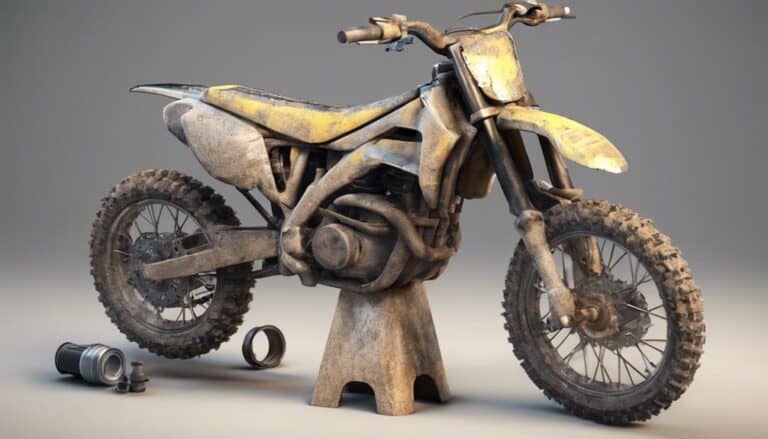When it comes to changing the engine oil in your dirt bike, imagine the scenario where a rider neglects this indispensable maintenance task. Ensuring the proper steps are followed is essential for the longevity and performance of your bike.
From draining the old oil to refilling with the correct type and quantity, each step plays an indispensable role in keeping your engine running smoothly.
Stay tuned to discover the intricacies of each step and why they are indispensable for your dirt bike's health and performance.
Key Takeaways
- Warm up bike, drain old oil, replace oil filter.
- Refill with recommended oil quantity.
- Check oil level and quality for proper lubrication.
- Dispose of old oil responsibly to protect the environment.
Drain Old Oil From the Engine
To begin the process of draining old oil from the engine, warm up your dirt bike to operating temperature for smoother flow and maximum drainage efficiency. Once the bike is warm, position it vertically and remove the skid plate to access the oil drain bolt easily. Place an oil pan underneath to catch the waste oil and prevent spills.
Locate the drain bolt on the engine and carefully loosen it to allow the old oil to flow out completely. Make sure to clean the oil filter cover thoroughly before removing it to maintain engine performance. After draining the old oil, clean the oil filter barrel and install a new oil filter.
Replace Oil Filter if Necessary
Inspect the oil filter for any signs of clogging, damage, or wear to determine if replacement is necessary for best engine performance. A dirty or damaged filter can lead to decreased engine efficiency and longevity.
If the filter appears dirty, torn, or has accumulated debris, it's essential to replace it to guarantee proper filtration of contaminants. Following the manufacturer's recommendations on the frequency of oil filter replacement is vital for best engine performance.
Installing a new oil filter during an oil change is a simple yet effective way to maintain the cleanliness of the oil and the overall health of the engine. By regularly replacing the oil filter, you can prevent harmful particles from circulating through the engine and potentially causing damage.
Prioritizing the replacement of the oil filter when needed is a proactive step towards safeguarding your dirt bike's engine and maximizing its lifespan.
Refill Engine With Fresh Oil
When refilling your dirt bike engine with fresh oil, make sure to adhere to the manufacturer's guidelines for the correct type and amount needed.
Before you start, guarantee the old oil has been completely drained from the engine by using the oil drain plug. Once the old oil is drained, locate the oil filler cap and use a funnel to pour the appropriate type and amount of fresh oil into the engine. Be precise to avoid spills that could damage surrounding engine parts.
It's vital to fill the engine with the recommended amount of oil to guarantee best performance and proper lubrication of the engine components. After refilling, securely tighten the oil filler plug to prevent leaks and ensure a proper seal.
Check Oil Level and Quality
Begin by evaluating the oil level and quality in your dirt bike engine using either the dipstick or sight glass. Ensure the oil is clean, transparent, and falls within the recommended level for best engine performance. Look out for any metal particles or discoloration in the oil, as these could be indicators of potential engine issues. Regularly checking the oil level and quality is vital to maintain proper lubrication, which aids in heat dissipation and overall engine performance. Promptly addressing any abnormalities in the oil level or quality is essential to prevent damage to the engine.
—
| Check the oil level | Look for clean, transparent oil |
|---|---|
| Inspect for metal particles | Ensure oil is within recommended level |
| Check for discoloration | Maintain proper lubrication |
| Monitor regularly | Address any abnormalities promptly |
| Ensure engine performance | Prevent potential engine issues |
Dispose of Old Oil Properly
To properly dispose of old oil from your dirt bike engine, locate a nearby recycling center or auto parts store that accepts used oil for recycling. Never throw away old oil in the trash or pour it down the drain, as this can harm the environment. Consider using an oil drain pan with a built-in spout for easy transfer of the used oil into a container for recycling.
It's important to adhere to your city or county's specific guidelines on how to dispose of used oil properly in your area. Recycling used oil is vital as it helps prevent pollution and conserves natural resources by enabling the oil to be re-refined and reused.
Conclusion
In summary, changing the engine oil in your dirt bike is a vital maintenance task to guarantee peak performance and engine health. Just like a well-oiled machine, your bike needs fresh oil to keep running smoothly.
By following these simple steps – draining the old oil, replacing the filter, and refilling with fresh oil – you can keep your dirt bike running like a well-oiled machine.
Don't wait until it's too late – give your bike the care it deserves!

